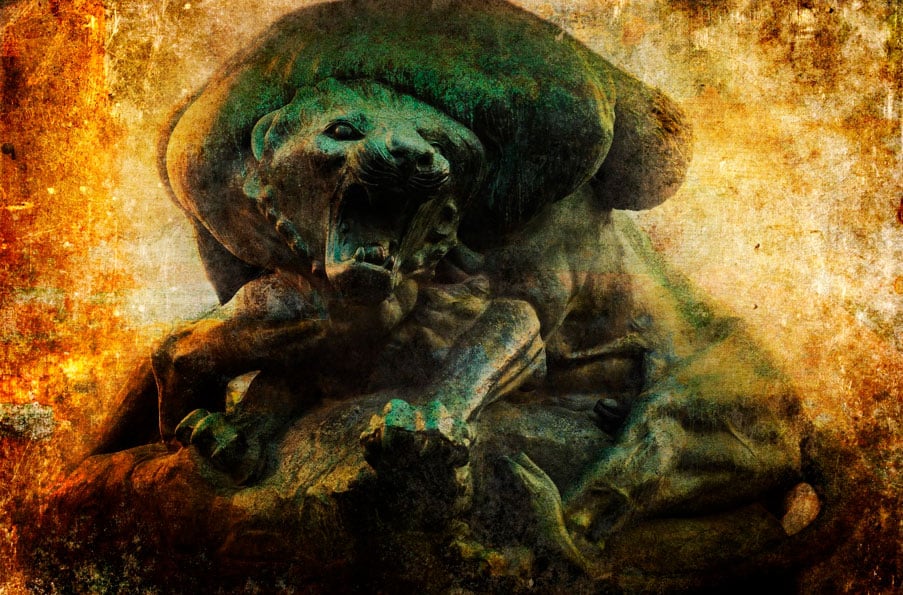Ancient Magical Incantation to Capture Evil Devourer Found in Turkey
The discovery of magical incantation that is 2800-years-old has been announced by experts. It was found at a site in south-west Turkey and is written in the ancient Aramaic language. The incantation referred to an enigmatic creature known as the ‘devourer’. It is offering researchers a unique view of the practice of magic in the Ancient Near East and its importance in a society from almost three millennia ago.
Live Science reports that the incantation was found at a site known as Zincirli, which was known as Sam’al in ancient times. This was a city that was founded by the Hittites and was later the capital of a small Aramean state that thrived roughly from 900 to 700 BC. reports. However, it lost its importance after it was conquered by the Assyrian Empire circa 700 BC.

Relief from the citadel of Sam'al (Zincirli), 730 BC (Richard Mortel / Flickr)
The incantation was found etched onto a reused cosmetic stone container in what is speculated to have been a shrine, during an excavation, conducted by German and American archaeologists. The findings were announced by Madadh Richey and Dennis Pardee at the yearly gathering of the Society of Biblical Literature.
Ancient Aramaic Incantation Describes 'Devourer' that Brings 'Fire' to Victims https://t.co/8He7MSJlnx pic.twitter.com/zEQjB7lnWE
— Live Science (@LiveScience) December 20, 2018
The Magician Rahim
The incantation was apparently inscribed by a practitioner of spells and magic. He was an adept in invocations and he was called "Rahim, son of Shadadan." Based on a study of the Aramaic used in the text, it was written sometime around 850 BC. This would make it ‘the most ancient Aramaic incantation that archaeologists have discovered to date’’, reports the Inquistir.
Rahim’s incantation describes the apprehension of a monster or creature that is known as the ‘devourer’. This beast was able to produce or emit fire and it appears that it was a menace to individuals. The incantation apparently was used to heal those who were being afflicted by the fire of the creature.
The blood of the captured beast was used to heal those who were afflicted by the ‘devourer’s’ fire. How the blood was used to treat the victim of the creature is not known. According to Richey, it is not known if ‘’the blood was given to the afflicted person in a potion that could be swallowed or whether it was smeared onto their body’’ according to Live Science.
- Ancient Ritual Bath Found in Jerusalem with Aramaic Graffiti on it
- Behistun Inscription, The Rosetta Stone of Persia
- The Lost Charms and Incantations That Molded Celtic Reality

Rahim’s incantation describes the apprehension of a monster or creature that is known as the ‘devourer’ (Erica Guilane-Nachez / Adobe Stock)
A Charm Against Scorpions?
The incantation is accompanied by some crudely etched images or illustrations that appear on both sides of the stone artifact. What they represent is a matter of conjecture, but they probably show a centipede, a scorpion, and possibly also some type of fish. This is leading to some speculation that the ‘devourer’ may have been a scorpion or even a centipede and that its ‘fire’ was its painful sting.
Coincidentally, after the container with the incantation was removed one of the local team members was badly stung by a scorpion and required emergency treatment.
The charm was dated to about the 9 th century BC, but it was found in a building or shrine that was possibly built up to 100 years later. This means that it was preserved for a considerable period of time and this would suggest that it was revered by the inhabitants of Sam’al and kept long after Rahim, the magician was dead. It seems that the local population believed that the spell continued to have some special powers. In the building, a small sculpture of a lion was also found, and it is dated around 900 BC. It may have once held the figure of a god or goddess.
The stone artifact with the spell is helping experts to have a better understanding of the importance of magic. Those incantations that were deemed to be effective were preserved in shrines or special places and this indicates the status of magic in Aramean society. The discovery is also allowing researchers to compare Aramean practices with those of other ancient societies and this can help us to understand the beliefs of the Ancient Near East almost 3000 years ago.
Top image: The incantation describes an incantation against a ‘devourer’ (Christian Müller / Adobe Stock)
By Ed Whelan

















